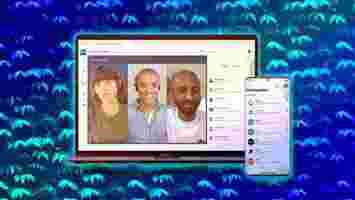Slack wants to make life easier for remote teams with its 5 new Workflow Builder templates
Did you know Tamar Yehoshua, Slack‘s Chief Product Officer, is speaking at TNW2020 this year? Check out their session on ‘Human-centricity: building products with customers’ here .

Factors affecting our work settings and daily lives may be beyond our control at the moment, but we can shape how we adapt and improve the way we work together while keeping our teams safe and healthy. (We should know – we just had to do the same thing ourselves.)
That’s why we’ve created five new templates for Workflow Builder , a visual tool that allows any Slack user to automate routine processes. From streamlining requests to gathering feedback, these templates are designed to make remote work feel like business as usual.
Speaking of making work simpler, we have just released a more organized Slack . You can find customized workflows for any channel by clicking the lightning bolt icon at the bottom left of your message box.
Update teammates on your status
When everyone is working from different places, be it a living room sofa or a different time zone, it helps to keep everyone in the loop without adding to their notifications. With this workflow, team members can easily complete a form to let others know where they’re working from. The form response is automatically sent to the channel, so team members and managers can easily keep track of one another.
Get your status update template .
Approve requests quickly
Filing and approving requests can be a cumbersome process even when you’re in the office. This workflow provides a customizable template so that you can easily track and approve employee requests such as expenses or travel . Have you introduced a new request policy and need to update your template? You can edit your workflow in just a few clicks.
Get your request approval template .
Remind your team to take breaks
Working from home tends to blur the boundaries between our personal and professional lives. You may find yourself hunched on the sofa for one too many hours or eating lunch at dinnertime.
This workflow sends your team scheduled reminders to engage in healthy habits, such as stretching, drinking some water or taking a short walk. Every day at a designated time, a message is posted in a channel of your choice with a reminder to take a break and practice some self-care. (While reading this now, do you realize that you haven’t taken a break in a few hours? Here’s your reminder to take a well-deserved time out.)
Get your healthy habit reminder template .
Kick off daily huddle reminders in-channel
When everyone is working from different locations, daily huddles are essential for keeping the team aligned. Instead of holding video meetings to list your priorities and blockers, huddles can happen in Slack channels – and we have a template for that.
Use this template to send a daily reminder to a team or project channel asking everyone to post an update on their work. Encouraging people to post their reply in a thread helps to keep channels clean and uncluttered. Plus, you’ll have a searchable history of everyone’s tasks, ensuring that no one is working on the same thing – all crucial to a smooth transition to working remotely.
Get your daily huddle reminder template .
Get feedback, no meeting required
Soliciting feedback from your teammates can be tricky when you aren’t in the same place. This workflow allows teams to collect ongoing feedback, which often replaces the need for a formal meeting.
It’s quite simple: set up your workflow so that when someone reacts to a message with the emoji of your choice, they’re sent step-by-step instructions – by way of a simple form – for sharing their feedback. Once submitted, the person who initially requested the feedback automatically receives new responses via direct message. Try this workflow if you’re gathering feedback for a pitch deck, blog post, or design.
Get your feedback request template .
This article was originally published on Slack’s blog by the Slack team. You can read it here .
Why digital events should be part of your marketing mix
For many companies, events have been a great way to grow their pipeline. Meeting people face-to-face, discussing what obstacles companies need to overcome and how your solution can help do just that (and more). It’s a place where people share experiences, thoughts, and here and there a smile. As Mastercard would say… PRICELESS.

Many of the companies I have been talking to in the past eight months have had a tough time as in-person event marketing has been a vital part of their marketing mix. Digital ads, content marketing, SEO, SEA, SEM, PPC, email, etc. are all great — and can be very effective to grow your business — but companies need to build relations (especially B2B SaaS). These companies need to make deeper connections and that’s when they’ve turned to in-person events.
But with no in-person events taking place since March, companies need to look at alternatives. Lead marketers and CMOs were forced to throw their strategy for 2020 in the bin and start from scratch. A lot of companies scaled down their marketing budgets at the beginning of the pandemic as a result of the uncertainty and the economic impact.
While that was most likely a wise decision at that time, it’s not viable for the long term. With churn going up and pipelines drying up, you need to take action to bring in new business.
Unfortunately it’s not as easy as moving budgets from in-person events to, say, PPC. In general, every channel has its limitations and cannot be scaled into infinity (otherwise you would have done so already, right?).
The alternative to in-person events are the digital equivalents, BUT here comes the issue. Not all digital events are created equally.
You’ve go really shit ones, while others are really great and valuable — the problem is you can’t tell which ones are which from their landing page. Thousands of digital events have sprung up and — just as with in-person events — most of them are not worthy of your time, let alone your precious marketing budget.
But this aside, the opportunity for your company in participating and sponsoring digital events is huge, arguably equal or even bigger than in person events. Why? Well, digital event presence scales better.
Think about it: no travel costs, no hotels, no travel time, a lot cheaper to participate. You can actually participate in multiple events with the same team on the same day. That’s IF you nail your digital events strategy.
We organized five Couch Conferences in May and June, as well as The Global Boardroom in collaboration with the FT in May, bringing together over 100,000 people at our digital events already.
The results for our partners are really promising — especially when they’ve had a clear plan for what they want to achieve — and there’s a lot more room to optimize. We’ve also advised partners on their own client events and helped them implement and execute their digital events strategy (if you want more details, ping me on Linkedin ).
Just like with in-person events you need to have a battle plan: how you are going to get the most out of the online event , how you are going to capture leads, how you’re approaching people, how you’re positioning your product on the digital events platform.
You also need to decide what story you’re telling at the event. Are you for example launching a new product? Or there to catch up with current clients? Are you perhaps testing a new market or product? Or looking to hire new digital talent?
Based on that, you need to determine who are the most suitable people to join the event from your team to execute your battle plan, and nail down how you are going to follow up after the event.
Event organizers — including us at TNW — have to help educate the market on how companies can get most out of their presence at digital events. I’m confident digital events are here to stay, even when in-person comes back. This belief also means that there’s a business model supporting it that works for all parties involved: exhibitors, sponsors, as well as event organizers and attendees.
So to sum up:
My take-it-or-leave-it-advice
Decide (and put down on paper!) whether and where digital events fit into your customer acquisition or retention journey.
Do your research and go beyond the landing page of an event before you decide to participate, exhibit, or partner with them.
Set your KPIs — which outcomes are you focusing on and can be measured?
Create a digital events battle plan.
Host an internal workshop with your sales and marketing team to discuss KPIs, responsibilities, and best practices.
Implement KPI tracking: make sure your conversations and leads are logged into your CRM and other tools.
Go out and test with a couple of digital events to try out your new strategy. The costs of digital events is lower, so it’s easier to fit more into your events budget.
Evaluate the results and adjust where needed.
Note: if you’re unsure or in doubt if digital events should be part of your marketing mix, a really good place to start is to attend a few events (start with TNW Conference ) with a small group of people — with marketing and sales at least — to experience and see what can be done, and how digital events can fit into your marketing strategy.
At TNW2020 we have tickets for all budgets available, I personally recommend a Business Pass (to get a good view, you want to have networking features) which is just €99 excluding VAT at the moment.
The problem with looking happy at work
Boris is the wise ol’ founder of TNW who writes a weekly column on everything about being an entrepreneur in tech — from managing stress to embracing awkwardness. You can get his musings straight to your inbox by signing up for his newsletter!

There’s a Seinfeld episode where George explains how he ‘works’ without actually doing anything. When Elaine and Jerry ask him how he gets away with doing nothing, he shares his simple trick: look serious and annoyed, and people will assume you’re busy.
We then see a few scenes of George looking angry, shaking his head, and mumbling as he paces around the office, while his coworkers treat his dedication with great reverence.
Not a bad tactic, George, although I completely disagree with it.
I recently met up with a friend over drinks and vented about a stressful project I was dealing with. I was slightly more open about my feelings than usual and at one point he remarked: “Wow, you always look and act so happy that I never realized you would feel stressed too.”
I was surprised for a moment and also oddly proud that I could hide my feelings well, but also aware of the cons of this tendency. There have been moments in the past where I’ve literally had to tell people, “don’t mistake my kindness for weakness.”
I’m a friendly fellow, which sometimes gives people the false impression that it means I’m also gullible or easy to take advantage of. So I guess it’s time I’ll have to add another warning to my collection, “just because I’m smiling doesn’t mean I’m not serious.”
I wish I wouldn’t have to do that, but it seems George was right about how people perceive ‘doing business.’
For me though, I’ve always believed in doing it with a smile, in being optimistic, and in acting friendly. The upsides of that are probably obvious, but the downsides are that we do think people have to look annoyed or brooding to be serious and think deeply about important things… while people who smile a lot must be a bit dumb.
I think that’s why it can seem attractive to some people to act more concerned or say they’re stressed about certain projects as it’s the only way we know how to interpret importance. And it’s understandable, as you’re not really allowed to deviate from that path.
If someone asks you how you’re doing and you say ‘great!’ with a smile, they might think you’re crazy. Haven’t you read the news? The world is going to shit! So why aren’t we all depressed?
Maybe that’s a fair question. In the face of doom, in the middle of a crisis, and with an uncertain future, it would be easy to lose your faith and stay optimistic. But there are people, more than you think, who are naturally optimistic and perk up when a challenge is presented.
They’ll smile comfortingly when you cry. They puff their chests up and laugh in the face of evil. They might go down in flames along with everyone else, but they’ll do it proudly and optimistically — and I feel that’s completely fine.
You shouldn’t need to act like George Costanza to be taken seriously at your job. You can be serious and dedicated while smiling and be quick to laugh. You don’t need to fake unhappiness to show you care about important issues — you should just be yourself.
Can’t get enough of Boris? Check out his older stories here , and sign up for his newsletter here .